The week at a glance
- American Coot still in Co Mayo
- House Crow still in Co Cork
- Possible Slender-billed Gull in Pembrokeshire
- Possible Pacific Diver in Cornwall
With no reports of the Cornish Green Heron, the only Nearctic mega was the American Coot, which remained at Termoncarragh Loch (Co Mayo) to at least 5th. The only other mega was the House Crow, which was in Cobh (Co Cork) to at least 7th.
A great almost-ran was a report of a possible first-winter Slender-billed Gull at Strumble Head (Pembrokeshire) on 5th, but sadly it was never relocated. With all previous records in the southeast, and the last being in 2000, this would have been a popular bird. Not quite so good, but still notable, was a possible Pacific Diver off Penzance (Cornwall) on 2nd.
Despite the snow there were no reports of Snow Geese, and the only Ross's Geese reported this week were with Pink-footed Geese, over Howick (Northumberland) on 3rd and in the Waxham and Winterton area (Norfolk) on 5th–6th. There may have then been another Norfolk bird, at Wells-next-the-Sea on 7th.
In Ireland, Black Brants were at Dungarvan (Co Waterford) to 7th and Annagh Head (Co Mayo) on 6th. Longer-staying birds remained in Dorset, where there were up to four around the Fleet, and in Hampshire at Hayling Island on 4th and Sturt Pond on 7th. There was also one at Snettisham (Norfolk) on 5th. Possibly wild Red-breasted Geese were with Dark-bellied Brent Geese at Dungeness (Kent) on 2nd, over Hinkley Point (Somerset) on 7th and still at Lodmoor (Dorset) to 5th, with the family party of less genuine birds still on the Suffolk coast.

Red-breasted Goose, Lodmoor RSPB, Dorset (Photo: Tony Hovell)
The Chew Valley Lake (Somerset) Ferruginous Duck was back this week (if it ever went anywhere) and the only other was the drake still at Corbet Lough (Co Down) on 5th. The drake Ring-necked Duck was also reported from Chew on 5th, with another drake at Ballyallia Lake (Co Cork) on 5th–7th and females again at Cork City (Co Cork) on 7th and a new bird at Threave (Dumfries & Galloway) on 7th–8th.

Ring-necked Duck, Threave, Dumfries & Galloway (Photo: Brian Henderson)
In Orkney, a new Lesser Scaup turned up, at St Mary's on 2nd–7th — only the third record for the islands and the first since 2000. The adult drake was also still in Cardiff Bay (Glamorgan) until at least 5th. Numbers of Green-winged Teal continued to drop, with the only ones reported at Caerlaverock (Dumfries & Galloway) to 7th and new drakes at Larne Lough (Co Antrim) on 5th–7th and Aberlady Bay (Lothian) on 7th. The female Blue-winged Teal was again at Bull Island (Co Dublin) to 4th and a drake was at Threave (Dumfries & Galloway) all week.
The female Surf Scoter remained off Dawlish Warren (Devon) to 5th, moving to Exmouth on 7th, and in Co Cork, females/immatures were reported from Aghada and Marloag Point on 5th-7th and from Cobh on 5th. The female King Eider was reported at West Voe of Sumburgh (Shetland) on 5th and was incredibly joined by a first-winter drake the same day.
Freezing temperatures may well have pushed more Smew to inland areas, with birds reported from 44 sites. There were also some good counts, including 11 at Pitsford Reservoir (Northamptonshire) and fours at Fen Drayton (Cambridgeshire), Cotswold Water Park (Gloucestershire) and Amwell Gravel Pits (Hertfordshire).
So late in the year, there were unlikely to be many shearwater records, but a count of 25 Balearic Shearwaters off Carbis Bay (Cornwall) on 7th was exceptional. The only other record was of two past Prawle Point (Devon) on 4th.
The two Glossy Ibis remained on the Otter estuary (Dorset) all week, and the only others were at Dunraven Bay (Glamorgan) again to 3rd and one over Axbridge (Somerset) on 4th. There was a rather reduced contingent of Great White Egrets this week, with the long-stayer at Pitsford Reservoir (Northamptonshire) augmented by birds at Trimley St Mary (Suffolk) on 5th, West Hythe and Sandwich Bay (Kent), Netheravon (Wiltshire) on 6th, Draycott (Somerset) on 7th and Radipole Lake (Dorset) on 7th. Apart from the long-staying singleton at Grouville Marsh (Jersey) to 5th, the only Cattle Egrets were brief ones, with two at Woodvale Airfield (Lancashire) on 5th and three east over Polgigga (Cornwall) on 7th.

Glossy Ibis, Dunraven Bay, Glamorgan (Photo: Raymond King)

Great White Egret, Sandwich Bay, Kent (Photo: Steve Ray)
Rather unusual was the single record of a White Stork, which paused for just five minutes on a rooftop at Holme-on-Spalding-Moor (East Yorkshire) on 5th before continuing southwest. Also out of place was an adult Night Heron reported at Guyhirn (Cambridgeshire) on 6th.
With fewer birders out due to the weather, and birds grounded for the same reason, the paltry 10 Rough-legged Buzzards reported was perhaps to be expected. The only northern birds were at Howman Law (Borders) and Nether Kellet (Lancashire), and two remained around Burnham Overy (Norfolk) and also around Louth (Lincolnshire). More seasonable-looking was an immature white-morph Gyr Falcon on Coll (Argyll) on 6th.
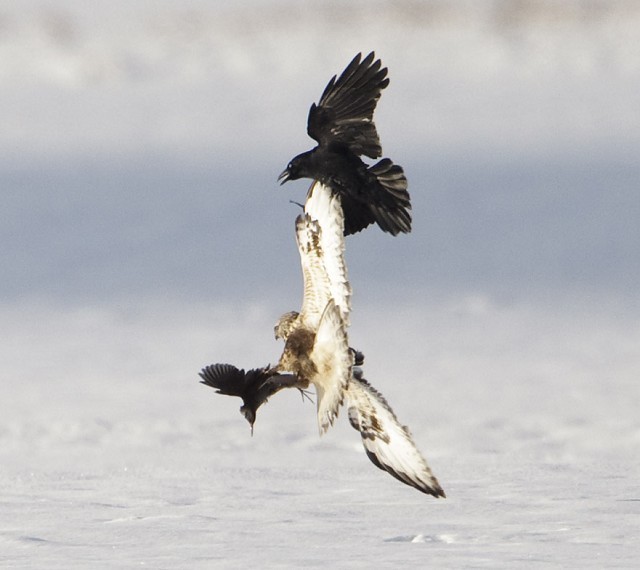
Rough-legged Buzzard, South Ferriby, Lincolnshire (Photo: Graham Catley)
The only lingering hint of an American Golden Plover was a possible reported from Trewey Common (Cornwall) on 5th, though not confirmed. Seemingly more at ease in the cold, the Long-billed Dowitcher stayed put at Lodmoor (Dorset) to 6th, the Lesser Yellowlegs was at Rutland Water again on 5th (after not being reported for a week) and the Dotterel remained at The Wig (Dumfries & Galloway) to 3rd. There were also far fewer Grey Phalaropes reported, with one braving the weather at Dunbar (Lothian) to 6th, though less fortunate was one at Filey (North Yorkshire) on 2nd that was found dead the next day. Others were then at Rutland Water to 4th, past Walcott (Norfolk) on 4th and on the river at Rainham Marshes (London) on 4th.

Long-billed Dowitcher, Lodmoor RSPB, Dorset (Photo: Tony Hovell)
Glaucous Gulls were reported from at least 15 sites during the week, including two juveniles at Swillington Ings (West Yorkshire) on 4th. Iceland Gulls were also reported from a similar number of sites, all singletons. Regular Ring-billed Gulls were again reported from Westcliff-on-Sea (Essex), Gosport (Hampshire), Sands Lane Gravel Pit (West Yorkshire), Portrush (Co Antrim) and Limerick (Co Limerick). New adults were then at Seaforth (Lancashire) on 3rd and Dargan Road Landfill Site (Co Antrim). Also in Ireland, the Co Galway Forster's Tern was reported from Nimmo's Pier on 3rd.
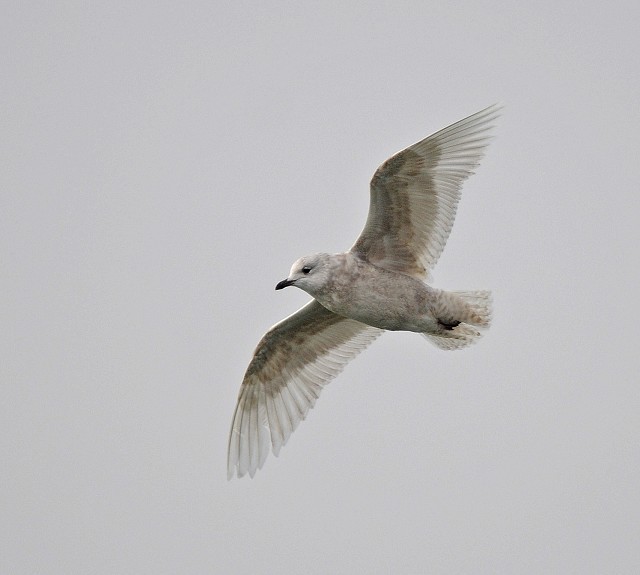
Iceland Gull, Lowestoft, Suffolk (Photo: Jon Evans)

Ring-billed Gull, Sands Lane GP, West Yorkshire (Photo: James Thomas)
It's likely that the various Shore Larks have remained, and that the smaller numbers being reported this week are because of fewer birders braving the coast. The only reported groups of note were 19 at Gibraltar Point (Lincolnshire), nine at John Muir Country Park (Lothian) and a new group of seven in off the sea at Bulverhythe (East Sussex) on 3rd. It's difficult to know where to start on Waxwings, as groups are now much more scattered and widespread. Suffice to say it's well worth looking at any berry-bearing trees and shrubs near you for some time! The largest group reported was 250 in Partick (Clyde), with 200s in Lancashire, Nottinghamshire, Shropshire and Staffordshire. Also remember to keep an eye out for any colour-ringed birds, and we'll have a brief update on the project soon.

Waxwing, Giltbrook, Nottinghamshire (Photo: John Dickenson)
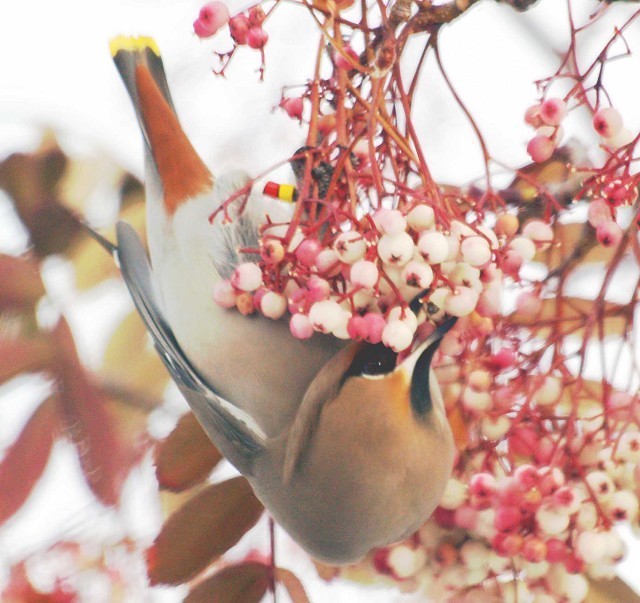
Waxwing, Stockton-on-Tees, Cleveland (Photo: Paul Welsh)
After the report of a late Richard's Pipit in Glamorgan last week, a large pipit at Freshwater West (Pembrokeshire) on 6th was either this species or more likely a Blyth's Pipit, causing much debate. Photos of the bird weren't conclusive, but did suggest the rarer of the two species. The remaining surviving Hoopoe stuck it out, present at Longham Lakes (Dorset) all week.

Hoopoe, Longham Lakes, Dorset (Photo: Pete Stringer)
The only remaining Yellow-browed Warbler was on St Mary's (Isles of Scilly) to 6th (along with nine Siberian Chiffchaffs, four Firecrests and two Black Redstarts). The Hume's Leaf Warbler became a definite this week, remaining in Wells Woods (Norfolk) to 3rd.

Yellow-browed Warbler, St. Mary's, Isles of Scilly (Photo: Joe Pender)

Hume's Leaf Warbler, Wells Woods, Norfolk (Photo: Andy Thompson)
Perhaps also weather-related, numbers of Great Grey Shrikes were down to just eight, which is surprising, with the furthest north at Bolton Abbey (North Yorkshire) on 7th. There was another brief Penduline Tit this week, though the bird at Dungeness (Kent) on 4th may have been the same as a bird a while ago, come out of hiding, though it did carry a very nice shiny ring. There was also a report of a fly-over bird at Hardley Staithe (Norfolk) on 5th. The only remaining Coues' Arctic Redpolls were in Wells Wood (Norfolk) on 2nd and again at Woodwalton Fen (Cambridgeshire) to 5th, with another possible at Cley (Norfolk) again on 5th.

Penduline Tit, Dungeness RSPB, Kent (Photo: Martin Casemore)
Small numbers of Lapland Bunting persisted, with peaks of 20 at Flamborough Head (North Yorkshire) and 11 at Spurn (East Yorkshire). Unusual wintering passerines were a Serin at Margate (Kent) on 5th (with 4 Firecrests) and the Common Rosefinch that hung on around the garden feeders on Bardsey Island (Gwynedd) to at least 7th.
Despite the atrocious weather, the occasional late migrant hung on, including a Turtle Dove in Cornwall on 3rd–4th, House Martin in Essex on 2nd, Ring Ouzel at Rainham Marshes (London) to 7th and a Lesser Whitethroat in Suffolk on 4th–5th. Apparent late summer migrants that probably have far more interesting origins included a possible eastern Yellow Wagtail at Colyford Sewage Works (Devon) on 4th–7th and a possible Central Asian Lesser Whitethroat in Kendal (Cumbria) on 2nd. Other unusual races that also popped up included a 'Nordic' Jackdaw in Wark (Northumberland) on 3rd and single Northern Long-tailed Tits at Sculthorpe Moor (Norfolk) on 4th and Middleton St George (Durham) on 5th.
Photo of the Week: 2nd–8th December 2010

Red-legged Partridge, undisclosed site, Lancashire (Photo: Tom Charles)
Liverpool-based bird photographer Tom Charles has been delighting us with his high-quality photo uploads for quite some time. Tom has a great eye for an image, always looking beyond his avian subjects themselves for opportunities to make the most of lighting, composition, behaviour or action. This week, photographing Red-legged Partridges in bright winter sunlight, Tom didn't just settle for static portrait shots. When the birds started to posture aggressively and then progressed to all-out combat, Tom kept his focus and recorded the action. In our favourite image, two partridges are in full contact in mid-air, feet and wings outstretched, and with one bird closing its eyes for protection. Although strongly reminiscent of the fighting Pheasants image that won our 2009 Photo of the Year, Tom's image additionally features a third bird. The inclusion of this 'spectator' adds interest to the composition, whilst its apparently relaxed demeanour conveys the fact that such fights are a part of everyday life for these creatures.
Other notable photos
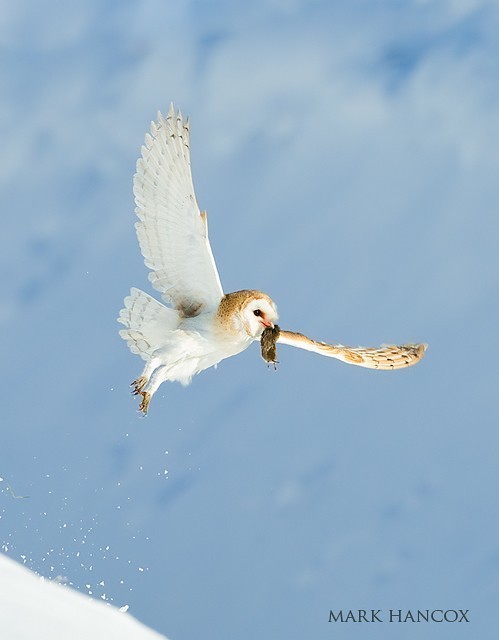
Barn Owl, undisclosed site, Shropshire (Photo:
Mark Hancox)

Starling, Gretna, Dumfries & Galloway (Photo:
Alan McFadyen)

Short-eared Owl, Worlaby Carrs, Lincolnshire (Photo:
David Newby)

Bittern, Minsmere RSPB, Suffolk (Photo:
Jon Evans)

Hoatzin, Peru (Photo:
Keith Dover)
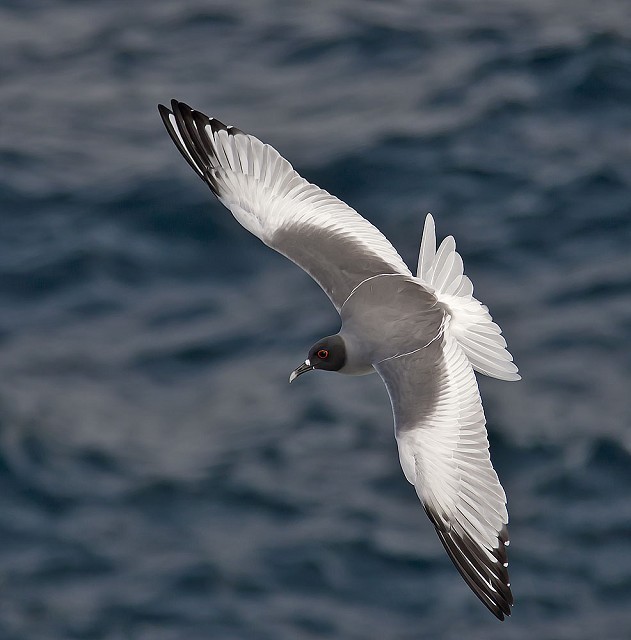
Swallow-tailed Gull, Ecuador (Photo:
John Anderson)

Red Kite, Echt, Aberdeenshire (Photo:
Alan Sinclair)

Waxwing, Giltbrook, Nottinghamshire (Photo:
Jamie MacArthur)

Jack Snipe, Wayoh Reservoir, Lancashire (Photo:
John Barlow)

Bearded Tit, Pennington Marshes, Hampshire (Photo:
Simon Johnson)

Common Buzzard, Bosherston Lily Ponds, Pembrokeshire (Photo:
Richard Crossen)

Common Kestrel, North Wirral, Cheshire (Photo:
Richard Steel)
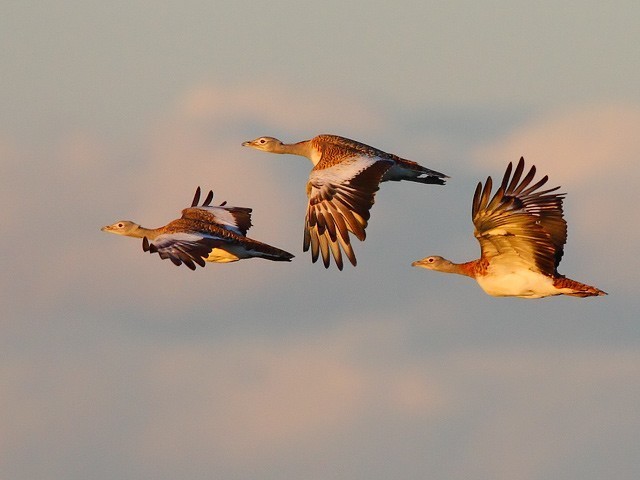
Great Bustard, Spain (Photo:
Steve Fletcher)

Water Rail, Bury, Greater Manchester (Photo:
Ivan Ellison)

Willow Tit, Knypersley Reservoir, Staffordshire (Photo:
Steve Seal)

Yellowhammer, Big Waters NR, Northumberland (Photo:
Terry Cavner)

Brambling, Leitholm, Borders (Photo:
Ron McCombe)

Ring-necked Parakeet, London Wetland Centre WWT, Greater London (Photo:
Tom Hines)

Robin, Llandrindod Wells, Powys (Photo:
Kev Joynes)

